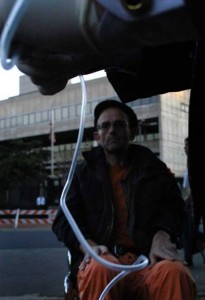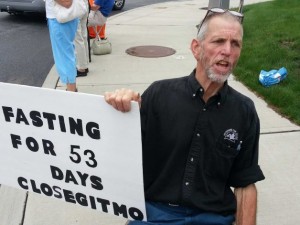How your body fights to keep you alive when you’re starving
http://io9.com/5941883/how-your-body-fights-to-keep-you-alive-when-youre-starving
The human body can go without oxygen for about five to ten minutes, and about three to eight days without water. But remarkably, people have been known to live upwards of 70 days without food. How is this possible?
The answer lies in a series of evolved physiological and metabolic defenses that work to keep you alive for as long as possible in the unfortunate event that you don’t have access to food. Just because you’re starving doesn’t mean you’ve become helpless. Here’s how your body fights to keep you alive and active.
By definition, starvation is a process. Our bodies are not like cars which immediately shut down when they’re out of gas. When we experience prolonged low energy intake, and as long as water is available, our bodies enter into a successive series of metabolic modes. It’s the body’s way of recognizing that food is scarce, and that it needs to re-allocate resources in preparation for what could be an extended period. In essence, your body is buying you some valuable time to give you a fair chance of finding some food.
0-6 hours after eating
Soon after eating, our bodies start to break down glycogen (molecules that store energy) to produce glucose (an important carbohydrate that fuels cells). When we’re eating normally, we use glucose as our primary fuel source; all is well, we’re happy, and in storage mode. Glucose gets packed into our liver and muscle, with the fatty acids getting stored around our body for (potential) future use.

In terms of energy allocation, our brains require 25% of the body’s total stored energy (which is a lot if you think about it), with the rest going to fuel our muscle tissues and red blood cells.
We can go for about six hours in this glucose-burning mode, which is why we tend to get a bit cranky if we have to go without food for longer than that.
Now that said, not everyone metabolizes energy in this way. Some individuals are in a state of ketosis in which they have elevated levels of ketone bodies — compounds that are produced when fatty acids are broken down for energy instead of glucose. People in ketosis include those on a ketogenic diet (a high-fat, protein rich, low-carbohydrate diet), or those who have just completed a long physical training session. Technically speaking they’re not starving — they’re just in a different metabolic mode.
6-72 hours after eating
 Expand
Expand
Now, whether you like it or not, you will enter into a state of ketosis should you go without food for six hours or more; this represents the first significant metabolic phase shift as you enter into starvation. At this point, all your glycogen stores will have been exhausted, and your body has no choice but to start hitting the fatty acids for energy. During lipolysis, fatty acids are directly broken down to produce ketone bodies.
Now all this is fine and well except for one very important thing: your brain cannot use fatty acids directly as its fuel source. These fats are large and cannot cross the blood-brain barrier. So, for the first 24 to 48 hours without food, your brain will continue to use the remaining glucose stores as fuel, while the rest of the body goes into the ketosis cycle.
Trouble is, the glucose isn’t enough; the brain requires about 120 g of glucose per day (the same amount of sugar found in three cans of soda!). At this rate, the brain would starve and die in about three days — but clearly it does not. This is because your body has evolved a backup plan.
It’s at this critical stage when the ketone bodies become all the more critical. Because they’re short-chain derivatives of fatty acids, they function as tiny powerpacks that can cross the blood-brain barrier and in turn be used by the brain as an alternative metabolic fuel. Your brain will get about 30% of its energy from ketone bodies on day three, but by day four it will jump to 70%. Moreover, your brain’s glucose requirement will drop from 120 g per day to 30 g once the body enters into this phase.
Fascinatingly, humans may be the only species who have brains that don’t require the ongoing ingestion of glucose to function. Most animals are forced to break down skeletal muscles at a higher rate. The going theory is that, because we humans are so greatly dependent on our intelligence to survive, we have evolved the capacity to stay cognitively sharp while in the midst of prolonged starvation, thus allowing us to search for food.
72 hours and onward
That said, your brain is not out of the woods yet. It’s still short of about 10 g of glucose per day. The brain has got to get its energy from somewhere, and that somewhere is your body’s own proteins. At this stage in your starvation (or fast), all the cells in your body will start to break down protein that releases amino acids into the bloodstream. These amino acids are then converted into glucose by the liver, and your brain is happy again.

But your body isn’t. You have now entered into the regrettable phase called autophagy where your muscle mass starts to waste away. You are literally cannibalizing yourself. Thankfully, our bodies are able to selectively decide which cells will break down and which will not — a process that balances the metabolic needs of the body, along with the critical need to prolong our ability to remain active (and look for food).
Death
Needless to say, the body is not doing so well despite these evasive maneuvers. Starvation wreaks havoc on the immune system, mostly on account of an extreme deficiency of vitamins and minerals. And in fact, some people will become weak and die of immune-related diseases during starvation.
Eventually, however, the body will run out of options. Glucose, fats, tissue, and muscle mass are finite resources that will eventually be exhausted, and with it, death. The end-stage of starvation typically brings with it one of two different diseases: marasmus and kwashiorkor.
Marasmus occurs on account of extreme energy deficiency, typically from inadequate amounts of protein and calories. At this point, body weight reaches dangerously low levels, and infections are common.
Kwashiorkor is a related disease that afflicts children who are protein-energy deficient, and can result in edema (fluidic inflammation) and an enlarged fatty liver — resulting in the counterintuitive distending of bellies, giving the illusory impression that starving children are well fed.
When death does finally arrive, its most immediate cause is by cardiac arrhythmia or a heart attack brought on by either extreme tissue degradation brought about by autophagy (notably diaphragm failure), or severe electrolyte imbalances.
People can die of starvation in as short as a three-week span, or as long as 70 days. During the Irish Hunger Strikes of 1981, for example, ten men survived without food (drinking only water) for periods ranging from 46 to 73 days.
To think that human life can be sustained for that length of time without food is nothing short of remarkable — a feat of biological engineering that’s the result of millions of years of painstaking and painful evolution.






